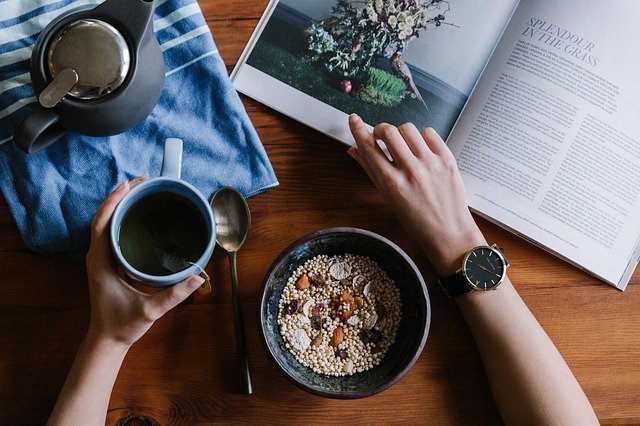Ways to Improve Your Diet
When you hear the word diet, do you roll your eyes and close your ears? It seems like there’s a new “world’s best” diet every few years. Why start a diet, when next year there will just be a new one, right?
Fad diets are definitely a waste of time but eating healthy will always be one of the most important ways to improve your health.

How can you do that when all the information out there is contradictory, unrealistic, or extremely complicated?
Don’t follow the hype. Stick with these nine simple and realistic ways to improve your diet and forget about trying the newest fad diet for good.
1. Fill Half Your Plate with Veggies
Vegetables are the most important part of a healthy diet. They contain so many helpful vitamins and minerals, fiber, and hydration with so little calories.
They fill you up both physically and nutritionally, helping you to curb cravings and prevent overeating.
Filling half your plate with vegetables helps you eat healthy in two ways. First, you get a good natural source of vitamins and second, you have less room in your stomach for the less healthy food choices.
2. Track Your Water Intake
We can be eating lots of nourishing foods but if we don’t get enough hydration into our system, we’ll still be lacking in energy.
In fact, many vitamins and minerals are water soluble, meaning that they need water to be absorbed into the body.
Literally, every system in our body from our digestive system to our circulatory system needs water to function properly.
How can you be sure to up your daily water intake? One good trick is to bring a water bottle with you everywhere and make it a habit to drink from this only.
If you’re really bad about staying hydrated, you know there’s an app for everything! Download Waterlogged on your phone. It’s free and it will send you reminders to drink up.
3. Make Your Plate Colorful
We’ve already discussed how important it is to get enough vegetables in your diet, but eating a variety of fruits and vegetables is important as well.
Every different color group of produce contains a separate group of antioxidants. For example, orange produce usually contains carotenoids, which are a group of antioxidants that include vitamin C.
Red produce often contains either lycopene or anthocyanins. Greens are high in chlorophyll and anticarcinogenic compounds, while purple and blue produce are high in anthocyanins.
When you construct your meals with a rainbow of colors, you are ensuring that you won’t be deficient in any of the varying vitamins and minerals.
4. Eat “Brown” Carbs
Carbohydrates have gotten a bad rap over the years, but the problem really lies in what has been done to the carbs before selling them to the public.
Carbohydrates are an essential macronutrient that delivers an immediate source of energy to your body and mind. Without them, we don’t function as good as we should.
Many healthy carbs are stripped of their nutrition before being put on the market. A good rule to follow is to look for carbs that still contain their natural brown color.
For example, when choosing bread, find the one with 100% whole grain written on the bag. Choose brown rice over white and whole wheat pasta or refined.
Even crackers can be healthy as long as they contain whole grains and aren’t too high in sodium, which can cause high blood pressure.
5. Plan Your Weekly Menu
When we lack a plan, we set ourselves up for failure. This is true of many areas of our lives, including our diet. Make eating healthy easier by planning your week of meals ahead of time.
When you don’t know what you are having for dinner, more often than not, you end up eating out or making a quick and convenient meal that isn’t very nutritious.
Packing your lunch is another great way to ensure that you don’t eat out or fall for any of the notoriously tempting office snacks.
6. Chew Longer
Intuitional eating allows your stomach to catch up with your mind. By taking the time to savor your food, you can satisfy your appetite with less food.
This involves putting away any distractions like your phone or tv and be fully attuned to the textures and flavors or your food.
7. Limit Boxes and Bags
Most foods that come in a box or a bag, besides bagged produce, are full of preservatives and additives. Think of most of your cookies, chips, and boxed dinners. These are the foods you want to avoid.
8. Cut Out Sugary Drinks
One of the biggest sources of sugar for most people is their drinks. Sodas, juices, and bottled coffees and teas have enormous amounts of sugar, which is the leading cause of obesity.
By cutting out this one food item, or severely restricting it, you can save yourself hundreds of calories per week and cut down on sugar crashes and addiction.
9. Make Healthy Eating Convenient
One of the biggest reasons many people fail at eating a healthy diet is the inconvenience of having to prepare a meal three times a day.
You can increase your odds of eating healthy by doing your best at making healthy eating more convenient for you.
This will include taking the time once a week to cut up fresh fruits and vegetables ready to grab and snack on, put little snack bags of nuts and low fat cheese or whole grain crackers, and have some precooked proteins to add to salads, wraps, and more.
Conclusion
Eating healthy doesn’t have to be hard, complicated, or boring. By putting a few of these simple tricks to work in your life, you’ll see results right away.
Succeed at all nine and you’ll be healthy as an ox!
